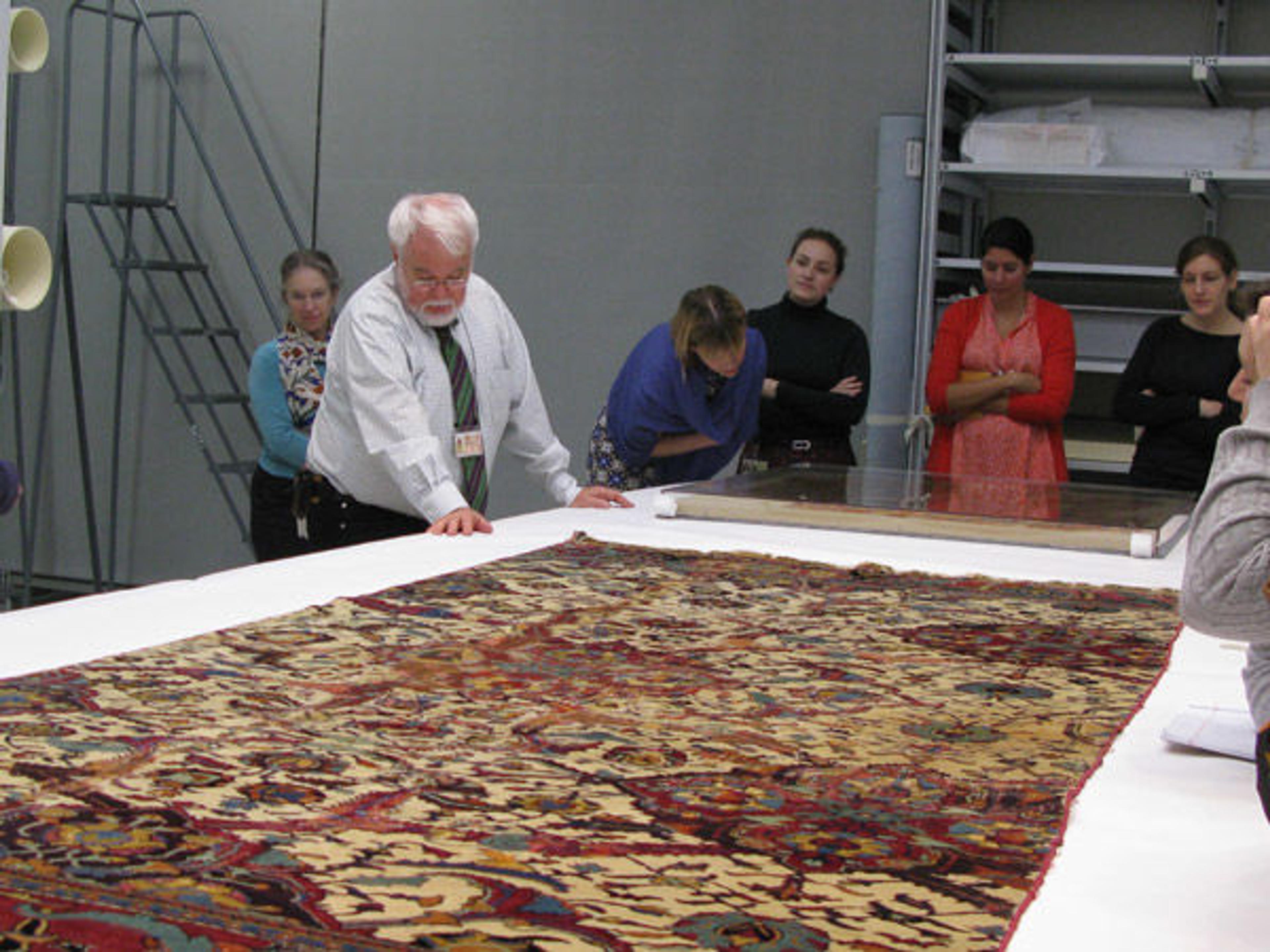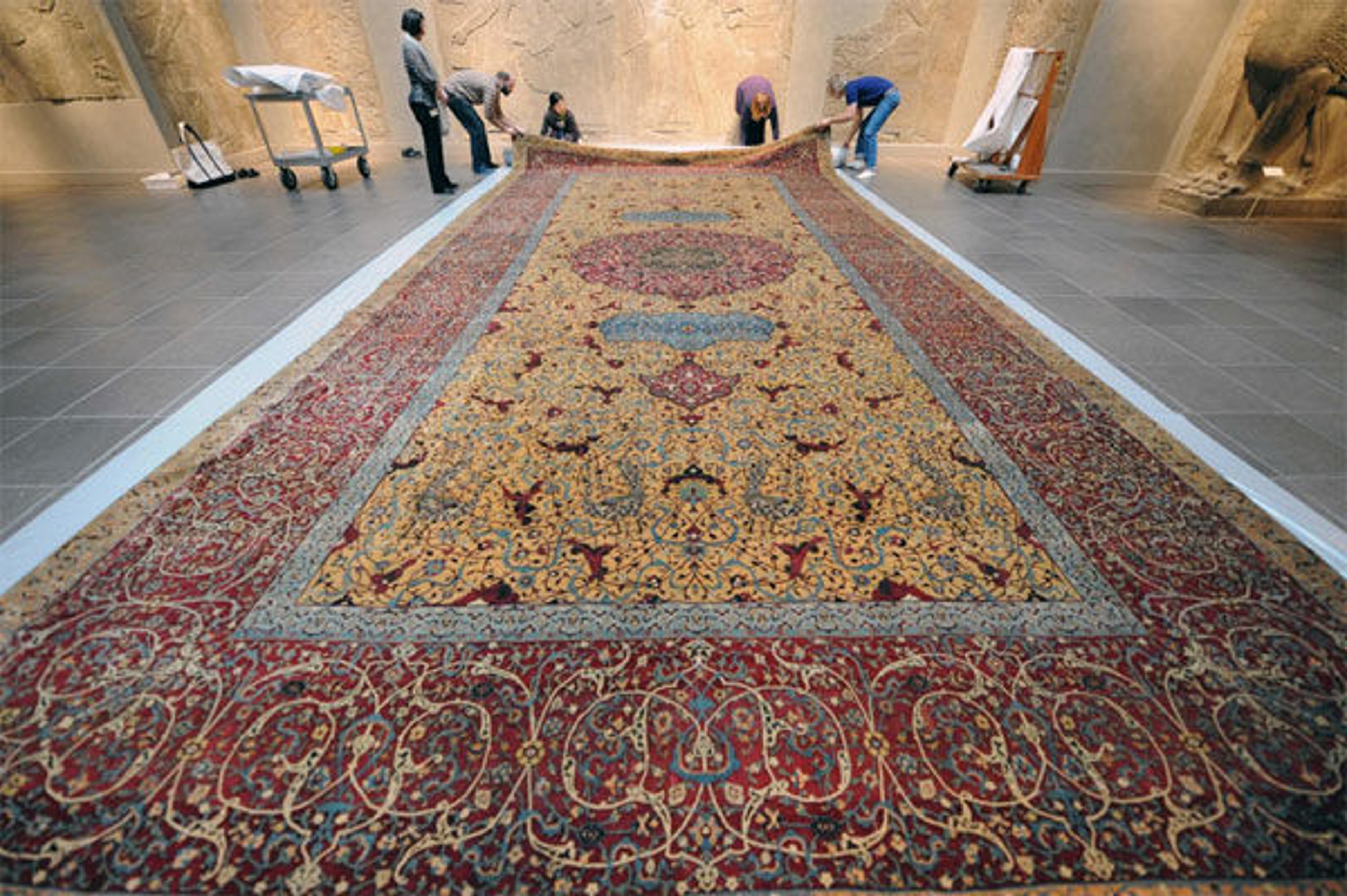
The author studies an Islamic carpet fragment with Met staff in the Antonio Ratti Textile Center. Photograph by Giovanna Fiorino-Iannace
From Antonio Ratti Textile Center Senior Manager Giovanna Fiorino-Iannace and Assistant Manager Eva Labson:
When asked to select a frequent visitor to The Metropolitan Museum of Art's Antonio Ratti Textile Center, the first name that came to mind is that of Walter Denny, the senior scholar in residence for Carpets and Textile in the Department of Islamic Art and author of the MetPublications title How to Read Islamic Carpets.
In honor of the twentieth anniversary of the opening of the Antonio Ratti Textile Center, Professor Denny described for us his interest in Islamic textiles and carpets, and the significance of his regular pilgrimages to the center. We would like to share his comments with the RumiNations readers.
«In Islamic art, textiles and carpets are in some ways the most emblematic works of their respective subtraditions. Carpets are by far the largest works of Islamic art, apart from architecture, in addition to being the most expensive and highly valued at the time of their creation. Textiles, especially silks, were important both artistically and economically, and costumes made from silk were perhaps, culturally, the most important art form. Both textiles and carpets traveled widely, and brought cross-cultural artistic contacts into fruition throughout the world, becoming an integral part of distant material culture. I find that textiles and carpets are also incredibly seductive. Their combination of texture, color, and relationships to other art forms made me, a would-be architectural historian, into a lover of these works for life.»
The study of textiles has a number of highly individual aspects. Unlike many media, textiles are fragile and highly reactive to light; they need special protocols for exhibition, handling, and storage, with specific controls in place regarding humidity, air quality, and illumination. In dealing with any aspect of textiles, from the creative process to authentication, close technical examination is essential. This subsequently leads to the paradox that while textiles should be touched as little as possible, the close contact with them is often quite necessary for research.

The author leads a study session on a carpet from the Met's collection in the Antonio Ratti Textile Center. Photograph by Giovanna Fiorino-Iannace
Here at the Met, I have found three really exceptional working environments: in the Department of Islamic Art, where the sense of mission and teamwork is really exceptional; in the Department of Textile Conservation, where I immediately made friends who will be with me for the rest of my life; and in the Antonio Ratti Textile Center, where during those early days of collection surveying I spent the majority of my time taking countless thousands of photographs, doing hundreds of analyses of carpets and textiles, and generally enjoying a supportive and hospitable environment for research.
The Ratti Center component of the preparation and planning for the new galleries for the Art of the Arab Lands, Turkey, Iran, Central Asia, and Later South Asia was not only essential, it was one of the biggest components. In those early days I was involved in a collection survey, and the biggest I had ever undertaken among the dozens I have done in museums all over the world over the past forty years.
The center's contributions to this effort were several. First, the closeness of the staff in both the center and the Department of Textile Conservation, coupled with their physical proximity within the Museum, meant that it was easy to share information and exchange views, object by object, as the survey progressed. Second, the Ratti Center staff was incredibly helpful in getting us the side-by-side comparisons that are essential to art-historical scholarship. And finally, of course, I was in the center dealing with a professional, knowledgeable, and incredibly generous group of colleagues—working in a culture that placed importance on helpfulness, accessibility, and a flexible approach to the job, a culture that made working there not only easy, but pleasant and joyful as well.

Museum staff work with the Anhalt medallion carpet in gallery 401, the Assyrian Royal Court. Photograph by the author
Not only does the center boast an organizational culture of hospitality and accessibility, with a fundamental goal of assisting scholarship that is exemplified in the staff, their training, their teamwork, and their sense of mission, but the physical facilities are among the best in the world: the space, lighting, a well-tested set of working protocols that balance the needs of the researcher with the obligations of the Museum to safeguard works of art, and facilities for microscopic examination, photography, and all of the other things a researcher needs. The center's expert colleagues also have the unique ability to give guidance, offer interesting opinions, and discuss aspects of research with the object while it's present in the same room as us.
All of this is a tribute to the center's senior manager, Giovanna Fiorino-Iannace, and her wonderful staff, but also to the overall guidance, beginning with Director Tom Campbell—who served as supervising curator when the center opened—and which continues now with its current supervising curator, Melinda Watt.
Related Event
The Antonio Ratti Textile Center will be celebrating its twentieth anniversary with a Sunday at the Met program on December 13, Behind the Scenes: Antonio Ratti Textile Center and Textile Conservation. Speakers will include Museum staff members Amelia Peck, Janina Poskrobko, Melinda Watt, and Florica Zaharia. The program will conclude with a live demonstration of embroidery techniques presented by Tricia Wilson Nguyen of Thistle Threads.
Related Publication
MetPublications: How to Read Islamic Carpets by Walter B. Denny